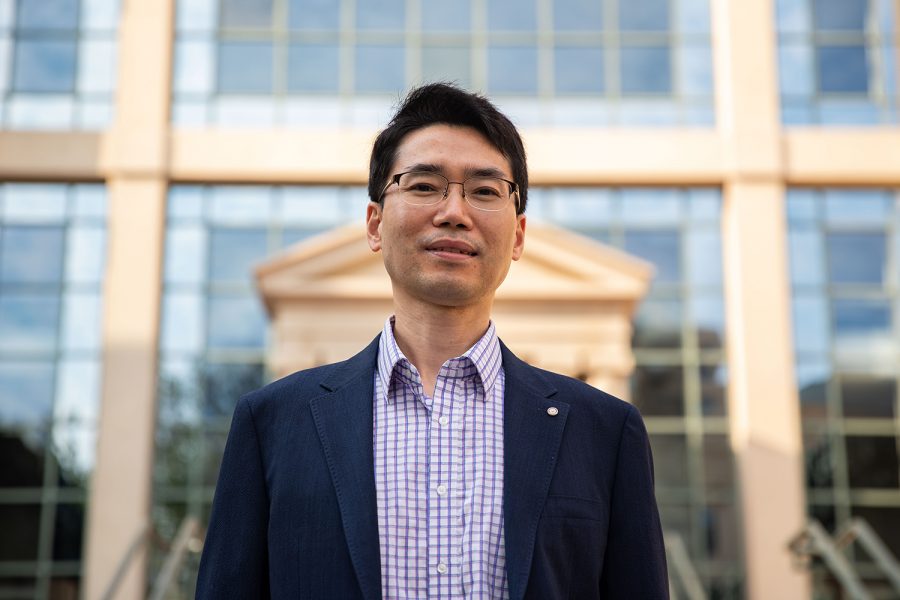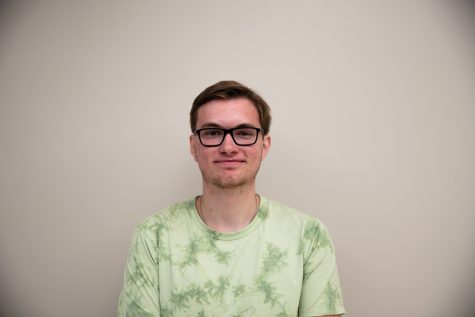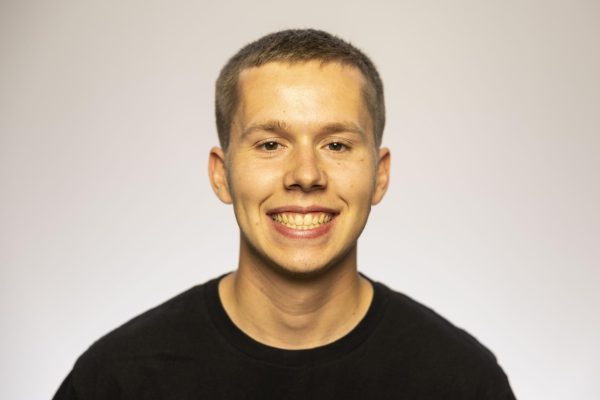UI professor uses machine learning to indicate a body shape-income relationship
University of Iowa professor Suyong Song and University of Virginia professor Steven Baek used old Air Force data to analyze the correlation between physical attractiveness and family income.
University of Iowa business professor Suyong Song poses for a portrait outside the Pappajohn Business Building on Monday, Sept. 13, 2021.
September 14, 2021
New research conducted by a professor in the University of Iowa Tippie College of Business shows evidence of a beauty premium, where someone who is more physically attractive based on modern beauty standards is paid more.
Professor of Economics Suyong Song’s study used data from 20-year-old research conducted by the U.S. Air Force, which included a socioeconomic survey and 3D full-body scans to gather precise measurements from participants.
Song said stature, or height, was positively correlated with family income for males. There was a negative correlation between obesity and family income for females, he said. The study maintained factors such as occupation, education level, and location of participants to ensure accurate results.
The data indicates a beauty premium, Song said, where someone who is more physically attractive based on modern beauty standards is paid more. When two individuals share the same abilities or level of education, he said the taller male makes an estimated $998 more on average annually than the shorter male.
For females, Song said a female with a smaller Body Mass Index would end up with a higher family income compared to a more overweight coworker by more than $930 annually. Both correlations were discovered in families that earn $70,000 per year.
Song said these characteristics — height and obesity level — were shared between both male and female data, but female hip-to-waist ratio emerged as a third important feature correlated with family income.
The Air Force data was collected during the Air Force’s Civilian American and European Surface Anthropometry Resource project from participants in North America, Italy, and the Netherlands.
Song said traditional studies of the beauty premium rely on self-reported measurements, which could create reporting errors.
“Instead of relying on surveyed, individual appearances, we can utilize this measured, three-dimensional scan data,” Song said. “We kind of resolve the issue of the reporting error in the existing literature.”
Steven Baek, an associate professor of data science at the University of Virginia and founder of the UI Visual Intelligence Laboratory, partnered with Song on the research study.
Baek said the research was unique because the 3D scans provided more than 100,000 data points across each participant’s body. To analyze this unique amount of data, Baek and Song used machine-learning technology.
“The role of technology was essentially to enable more accurate quantification, more accurate representation of human body shape using the tools of machine-learning,” Baek said.
The algorithm, he said, was responsible for creating its own ways of describing the body shapes of the participants, to remove researcher subjectivity from the equation.
Song said in more traditional studies of the beauty premium, researchers delivered very subjective evaluations of someone’s beauty based on survey questions about attractive facial or physical beauty.
The machine-learning technology helped Song and Baek compress and analyze a massive amount of extremely accurate data, Baek said.
Song said he believes more workplace awareness and education about the beauty premium could help to alleviate the correlation between physical attractiveness and family income that the study details. He said interviews conducted over the phone or virtually could help reduce the correlation, but wouldn’t entirely solve the problem.
“You can’t tell I’m six feet tall through this virtual interview,” Song said in a phone interview with The Daily Iowan. “[Through] this kind of virtual setting or phone call setting, we can have partially reduced implicit bias in the hiring process. It’s not perfect either, because the hiring process is not the only reason why we have this beauty premium.”
Dana Dominguez, the associate director of operations and communication at the UI’s Pomerantz Career Center, wrote they hired a new staff member in August whose role is to work with employers on increasing awareness of disparities such as the beauty premium.
She said the center has also been involved in helping their employer partners recognize and learn from statistics and research about these biases.
Dominguez wrote in an email to the DI that the center is working to “educate organizations on bias in recruitment, hiring, and other important decisions in the workplace, and ultimately reduce the gaps and disparities that may be present within their own organizations.”
Baek said given the complexity of this issue, there is no single solution that exists. The first step is to recognize and understand that there is this income disparity between more physically attractive and less physically attractive individuals, he said.
“I don’t believe that my mission is to provide the solutions,” Baek said. “But rather, it’s more on raising the issue and throwing out questions to policy-makers and corporate leadership, so that they can start thinking about what changes to make.”
















